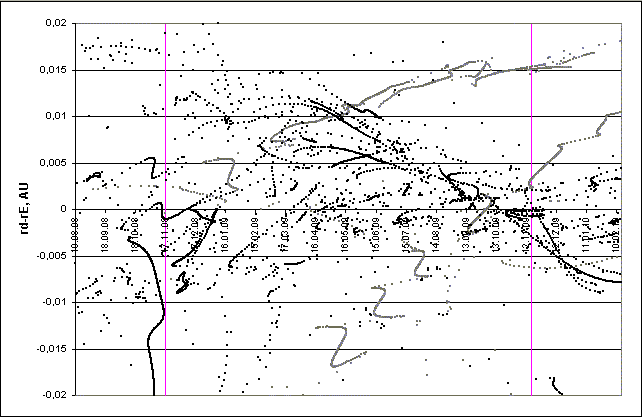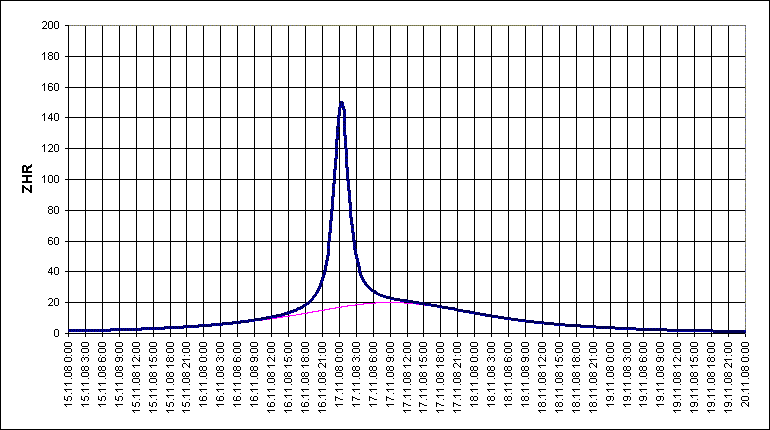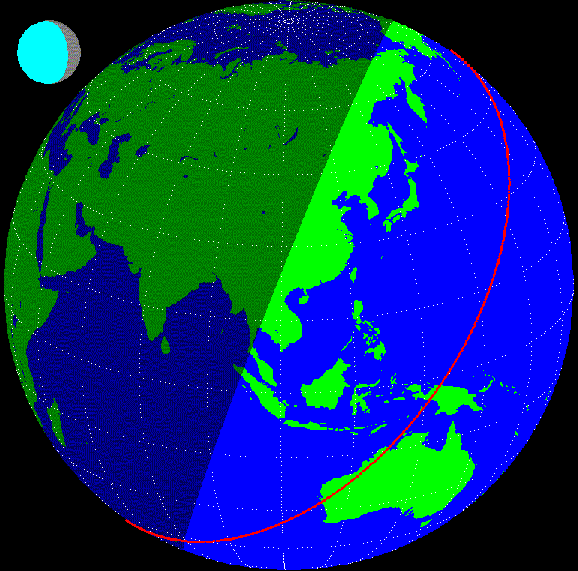Leonids 2008: prediction of activity
to the list of predictions
Introduction
Computation characteristics
We'd like to introduce the results of Leonid meteor stream simulation aimed to the prediction of shower activity in 2008. The simulation was made for the trails of latest 30 revolutions, i.e, from the 1001 trail. The Author used the program by S. Shanov and S. Dubrovsky to calculate orbital elements of ejected meteor particles. To estimate expected ZHRs for different encounters the model by E. Lyytinen and T. van Flandern given in their paper [3] was used with some Author's alterations made in order to adopt the model for ejection velocity (Vej) instead of da0 (difference in a-semimajor axis) as well as to correct fn function to consider factual Leonids activity during recent storms and outbursts. The computation considered only gravitational forces. The following parts of trails were computed: the first 5 rev. trails for ejection velocities [-50;100] m/s, 6-10 rev. trails - [-30;50] m/s, 10-20 rev. trails - [-20;30], older than 20 rev. trails - [-10;20] m/s.
Results
Introduction
Computation characteristics
We'd like to introduce the results of Leonid meteor stream simulation aimed to the prediction of shower activity in 2008. The simulation was made for the trails of latest 30 revolutions, i.e, from the 1001 trail. The Author used the program by S. Shanov and S. Dubrovsky to calculate orbital elements of ejected meteor particles. To estimate expected ZHRs for different encounters the model by E. Lyytinen and T. van Flandern given in their paper [3] was used with some Author's alterations made in order to adopt the model for ejection velocity (Vej) instead of da0 (difference in a-semimajor axis) as well as to correct fn function to consider factual Leonids activity during recent storms and outbursts. The computation considered only gravitational forces. The following parts of trails were computed: the first 5 rev. trails for ejection velocities [-50;100] m/s, 6-10 rev. trails - [-30;50] m/s, 10-20 rev. trails - [-20;30], older than 20 rev. trails - [-10;20] m/s.
Results

Fig. 1. Space-temporal projection of Leonids trails parts onto their minimal distance passages diring the period 18.08.2008-15.02.2010 (correspondence between colours of the particles and their ejection velocities can be seen here).

Fig. 2. Detailed space-temporal projection of Leonids trails parts onto their minimal distance passages diring the period 18.08.2008-15.02.2009 (correspondence between colours of the particles and their ejection velocities can be seen here).

Fig. 2. Detailed space-temporal projection of Leonids trails parts onto their minimal distance passages diring the period 18.08.2009-15.02.2010 (correspondence between colours of the particles and their ejection velocities can be seen here).
Leonids in 2008

Fig. 4. Assumed profile of overall Leonid activity (blue line) and its background component (red line).
In 2008, prior several hours to the traditional maximum (which should occur at 5 UT 17 November, as IMO states), we expect outburst of the Leonids due to 1466 trail. That is shown on the Fig. 4. Computed time of maximum - 0:22 UT 17 November, computed peak intensity, according to the most recent estimations, is 150 meteors on ZHR scale. Theoretical radiand of trail meteors: RA=153.5°, Dec=+22.1°.
It should be noted, that this outburst is to happen 10 years after parent comet perihelion, and it is connected to quite old trail. These considerations make lower the reliability of the prediction, significantly lower that, for instance, predictions for Leonid outbursts from 1932 trail in 2006 and 2007. So far, the observations should show what happens really.
It should be noted, that this outburst is to happen 10 years after parent comet perihelion, and it is connected to quite old trail. These considerations make lower the reliability of the prediction, significantly lower that, for instance, predictions for Leonid outbursts from 1932 trail in 2006 and 2007. So far, the observations should show what happens really.

Fig. 5. The Earth as seen from coming Leonid meteors (Radiant: RA=153.5°, Dec=+22.1°)during the peak at 0:22 UT 17 November. Red line shows the border of hemisphere where the Moon is above horizon (it is shown with in the corner of the Fig. 5 according to its phase).
The Fig. 5 shows the map with regions where this peak would be visible if occured at given time. So far, the best place for observations would be the most part of Eurasia. The sky will be already too light for visual observations in Far East, to the east of the lake Baikal, as well in South-Eastern Asia, to the east of appr. 90°E. To the West the zone of visibility will be limited by the line appr. from Black sea to Cola peninsula. The padioobservations, besides the zone of visual observations, will be possible in the whole Sounth-Eastern Asia and Far East, as well as on almost all territory of Australia, exludind the south-eastern edge of the continent.
The waning gibbous Moon in 2008 will be a serious problem for visual and videoobservations, as it will shine during the whole second hald of the the nignt, when Leonids radian rise high in the sky. However, we recommend to make observations anyway, as brightness of 1466 trail meteors is expected to be higher than average, and considerable outburst of activity, if occurs, will be very remarkable despite the Moon.
Леониды в 2009 г. (overview)
The Fig. 3 shows the parts of 1466 and 1533 trails, which are expected to give Leonid outbirsts in 2009. The action of these trails will be mixed, in the whole thay should produce activity with maximum of 150-160 meteors on ZHR scale (including background) at 21-22 UT on 17 November, perhaps with a number of submaximas. Also, small enhancements is possible at 19 UT on 18 November from 1201 trail.
References
1. "Comet's dust 2.0" program by S. Shanov and S. Dubrovsky. [Used for orbital computations.]
2. Information from Gary W. Kronk's page http://www.maa.agleia.de
3. Lyytinen E, van Flandern T. "Predicting the strength of Leonid outbursts", 2000, Icarus, P. 158-160.
The waning gibbous Moon in 2008 will be a serious problem for visual and videoobservations, as it will shine during the whole second hald of the the nignt, when Leonids radian rise high in the sky. However, we recommend to make observations anyway, as brightness of 1466 trail meteors is expected to be higher than average, and considerable outburst of activity, if occurs, will be very remarkable despite the Moon.
Леониды в 2009 г. (overview)
The Fig. 3 shows the parts of 1466 and 1533 trails, which are expected to give Leonid outbirsts in 2009. The action of these trails will be mixed, in the whole thay should produce activity with maximum of 150-160 meteors on ZHR scale (including background) at 21-22 UT on 17 November, perhaps with a number of submaximas. Also, small enhancements is possible at 19 UT on 18 November from 1201 trail.
References
1. "Comet's dust 2.0" program by S. Shanov and S. Dubrovsky. [Used for orbital computations.]
2. Information from Gary W. Kronk's page http://www.maa.agleia.de
3. Lyytinen E, van Flandern T. "Predicting the strength of Leonid outbursts", 2000, Icarus, P. 158-160.